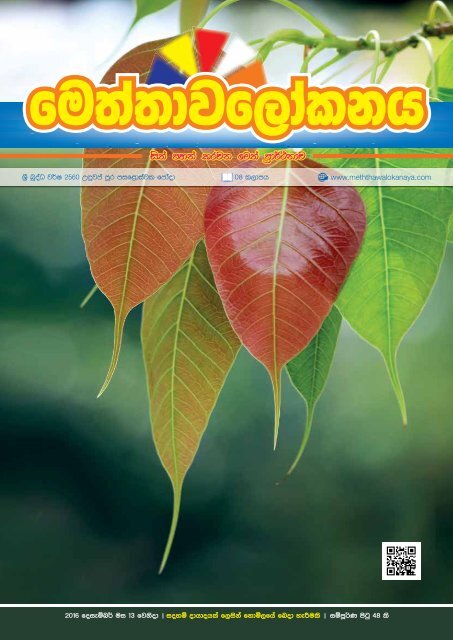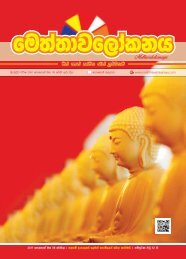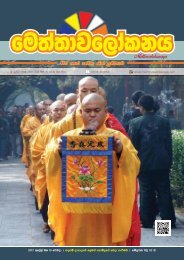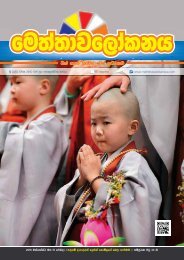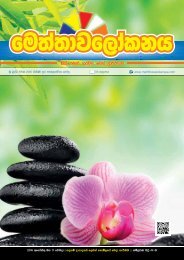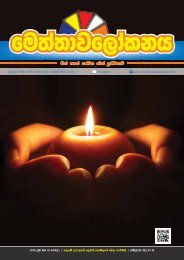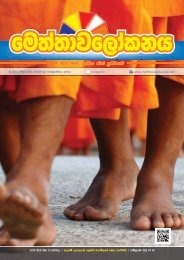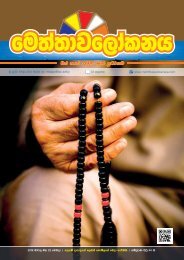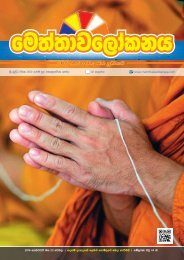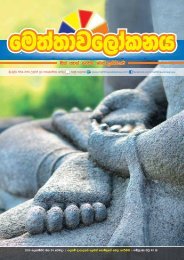Mettavalokanaya Buddhist Magazine - December 13 2016
Sri Lankan most popular & leading Buddhist Magazine “Mettavalokanaya” Buddhist Magazine - December 13 2016
Sri Lankan most popular & leading Buddhist Magazine “Mettavalokanaya” Buddhist Magazine - December 13 2016
Create successful ePaper yourself
Turn your PDF publications into a flip-book with our unique Google optimized e-Paper software.
2 fu;a;djf,dalkh I foieïn¾ I <strong>2016</strong><br />
www.meththawalokanaya.com
fu;a;djf,dalkh<br />
iaúÜi¾,ka;hg yd m%xYhg'''<br />
iaúÜi¾,ka;fha cskSjd kqjr cd;Hka;r fn!oaO uOHia:dkfhA oS'''<br />
m%xYfha meßia kqjr Y%s ,xld meßia fn!oaO úydria:dkfha oS'''<br />
m%xYfha meßia kqjr , nq¾fIa cd;Hka;r fn!oaO uOHia:dkfhA oS'''<br />
—fu;a;djf,dalkh˜ udisl fn!oaO i`.rdj wdrïN lr<br />
jirla imsfrkakg;a u;af;ka Èjhsfka i;r È.aNd.fhka<br />
fukau f,dj kka foiska o Èfkka Èk .,d tkafka iqnjd§<br />
m%;spdrhka h'<br />
fu;rï blauKska fndÿkq ck;dj fj; jvd;a ixfõoSj<br />
iómùu ieneúka u —fu;a;djf,dalkh˜ ,o Nd.Hhls'<br />
u,aj;=" wia.sß" wurmqr yd rdud[a[ hk ksldhkays<br />
ish¨u w;sf.!rjKSh jQ uydkdhl udysñmdKka jykafia,d<br />
we;=`M wfkl=;a ksldhkays" md¾Yajhkays uydkdhl" wkqkdhl"<br />
f,aLldêldÍ kdhl iajdókaøhdKka jykafia,dg;a"<br />
Èjhsfka ish¨u Èia;%slalhkays msysá ft;sydisl yd m%isoaO<br />
úydria:dkhkays kdhl iajdókaøhdKka jykafia,dg;a<br />
udislj mQcd lrkq ,nk —fu;a;djf,dalkh˜ udisl fn!oaO<br />
i`.rdj" miq.sh jma mqr mifkdhl" rdclSh mKaä;" wdpd¾h w;sf.!rjd¾y<br />
uqrex.d.iahdfha [dKSiair kdhl iajdókaøhdKka jykafiag<br />
o —fu;a;djf,dalkh˜ udisl fn!oaO i`.rdj uy;a f.!rj<br />
fmr±ßj mQcd lrkq ,eîh'<br />
wk;=rej" m%xYfha meßia kqjr msysá Y%s ,xld meßia<br />
fn!oaO úydrh fj; o f.dia tys úydrdêm;s w;sf.!rjd¾y<br />
fldaka.iafoKsfha wdkkao kdhl iajdókaøhdKka jykafiag<br />
o —fu;a;djf,dalkh˜ udisl fn!oaO i`.rdj fu;a is;a<br />
fmr±ßj mQcd lf
jmqrk îc j,g wkqj M,odj<br />
,efnkakd fia<br />
l¾u /ia lsÍu<br />
wm ,enQ ukqIH wd;auh<br />
wdrCId lr.ekSu w;sYhska<br />
u ÿIalr jQjls<br />
—hdÈix jmf; îcx - ;dÈix yrf; M,x - l,HdKldÍ<br />
l,HdKx mdmldÍ p mdmlx˜ - f.dúuyf;l= úiska hï<br />
îchla jmqrkd úg ta îc j,g wkqj u wiajekakla ,efnkakd<br />
fia wm úiska fkdfhl=;a jr isoaO lr.kakd jQ l=i," wl=i,<br />
l¾uhka ksid l=i,a yd wl=i,a /ia lr .kS'<br />
ta wkqj" hfula úiska hï hym;a lghq;a;la isÿ<br />
lrkafka kï bka hym;a jQ l=i, l¾u;a" ;j;a hï flfkl=<br />
úiska whym;a jQ foa isoaO lrñka isákafka kï bka wl=i,<br />
l¾u;a d;kh fyda ta i;aj ysxikh lsisúfgl;a fyd`o<br />
fohla jYfhka f,dalhd úiska ms
W`ÿjma mqr mifñ;a;d uyry;a uyf;rKsh W;=ï jQ ch Y%S uyd<br />
fndaëka jykafia jevu lrjdf.k ,xldjg iem;a jQfha wfma<br />
rfÜ pqkakdlï m%foaYfha —cïnqflda, mÜgk˜ fyj;a oUfld<<br />
mgqkgh' wo fmaÿre;=vqj wi, —yqKq.u˜ kñka y`ÿkajk<br />
fuu ia:dkfha isg bka wk;=rej mqkÍka" ;sjlal nuqKq.u"<br />
;ka;sßu,h yryd uy;a jQ .re ie
isõ wdldrfha mqoa.,hkaf.ka<br />
Tn ljr mqoa.,fhla o@'''<br />
Tn" Tnf.a w;HdjYH .ukla hdug ksjiska msgj .shd<br />
hehs is;kak' Tn .uka .kakd ud¾.fha § fndfyda mqoa.,hka<br />
Tnf.a fk; .efÜú' Tjqka ish,a,la u úúOdldr fõ' fï<br />
úúOdldr jQ ñksiqka ish,Qu fokd wm uyd ;:d.;hdKka<br />
jykafia úiska jfrl j¾. fldg jod
www.meththawalokanaya.com<br />
fu;a;djf,dalkh I foieïn¾ I <strong>2016</strong> 7
Èúhl we;s<br />
jákdu yrh kï'''<br />
mskaj;aks" wo wms yefuflfkl=u wdorh fidhkjd"<br />
ñ;%;ajh fidhkjd' fï lshkd ufkdaNdjhka wm ;=< ljr<br />
wdldrfhka o f;areï wrf.k mqreÿ mqyqK l< hq;af;a lshk<br />
ldrKdj iïnkaOfhka fndfyda fofkl=f.a wjOdkhla yß<br />
yeá fhduq fj,d keye' th ksjerÈj wjfndaO lr .ekSu wo<br />
ld,fha yeáhg w;sYhska u jeo.;a ldrKdjla'<br />
;sf,da.=re nqÿmshdKka jykafia" ;uka jykafiaf.a<br />
idxidßl cSjk .ufka § lrk ,o mÍCIKh wjidkfha §<br />
wjfndaO lr .;af;a" —mrud¾: jYfhka .; l< wdorh yd<br />
fm%auh lshkd fï ish,a,la u ÿl iy Nh Wmojk tajd˜ njhs'<br />
kuq;a mskaj;aks" Tn cSj;a fjkafka iïuq;s f,dalhl'<br />
fï iïuq;s i;Hh ;=< wms cSj;a fjoa§ Nh ysf;k tl" ÿl<br />
ysf;k tl" B¾Ishdj we;s fjk tl iïuq;s iïnkaOhka j,§<br />
b;du;a idudkH ;;a;ajhla'<br />
Ydka;s kdhlhdKka jykafia mrud¾:uh jYfhka<br />
wmg uy;a lreKdfjka hqla;j foaYkd lrkq ,enQfha mQ¾K<br />
wjfndaOhl§ fï ish,a,lau w;yeßh hq;= njhs' tjka<br />
mrud¾:uh ldrKdjla foaYkd l
ljqo@ Tn ys;kak tmd wmg jvd my< flfkla ljrodlj;a<br />
wmj ksjerÈ lrhs lsh,d'<br />
.%Sisfha my< jqKq b;du;a fY%aIaG od¾Ykslfhla<br />
lshkjd ;ukaf.a hd`Mjg" —Tn uf.a biairyska hkak tmd'<br />
ta fudlo@ ug neye Tfí wkq.dñlhd fjkak' ta jf.au Tn<br />
uf.a miqmiska tkak;a tmd' ta fudlo@ ug neye Tfí u`.<br />
fmkajkakd fyda iajdñhd fjkak' Tn uf.;a tlal iudkj u<br />
weúof.k hkak˜<br />
taflka fmkajd fok fndfydu jeo.;a ldrKdjla<br />
;sfhkjd mskaj;aks" wms fyd`o hd`Mfjda fjkak ´fka kï<br />
wms w;r hï iudk;djhla ;sfhkak ´fka' wms wdOHd;añl<br />
jYfhka fukau fN!;slj;a iudk fjkak ´fka' wd¾:sl<br />
jYfhkq;a ;uka iy ;udf.a hd`Mjd iudk ke;akï" wiudk<br />
kï t;k;a we;sfjkafka m%Yak u ;uhs'<br />
mskaj;a Tn fudfyd;la ys;kak" Tng jvd i,a,s ;sfhk"<br />
Tng jvd n,h ;sfhk flfkla Tfí fyd`o u hy`Mjd<br />
jqkyu wmg thd .ek ysf;kafka thdj wfma jev j,g<br />
mdúÉÑ lr.kak ú;rhs fkao@' w;sYh ióm ñ;%;ajhla we;s<br />
lr.kak ysf;kafka keye t;fldg'<br />
ta jf.au uu Tng fï wjia:dfõ § u fhdackd lrkjd"<br />
;ukag jvd wiudk whj ;ukaf.a hd`Mlug ú;rla fkfjhs"<br />
ta whj lido n`Èkak;a tmd lsh,d' neßfj,dj;a Tn ta jf.a<br />
wh újdy lr.;a;yu fjkafka" wdorh" lreKdj we;=f,a<br />
,efnkak ´k ukd iqrCIs;;djh ta whf.ka Tng fkd ,eî<br />
hdu hs'<br />
wdOHd;añlj yd fN!;slj wmg jvd Okfhka" n,fhka<br />
yd Yla;sfhka jeä flfkla tlal wms ñ;%lula f.dvk`.d<br />
.kak .shyu fjkafka" thd wmj lju ljrodlj;a ksjerÈ<br />
lrkak W;aidy fkd .ekSu hs'<br />
wkak tfyukï ±ka Tng jegfykjd we;s fï hd`Mlu"<br />
fï ñ;%;ajh" fï iqyo;ajh" fï wdorh wm we;s lr.kak<br />
´fka ksrka;rfhka u iudkhska w;r ñila Bg jvd my< fyda<br />
by< wh;a tlal fkfjhs lshk tl'<br />
mskaj;aks" fuf;kaÈ uu Tng fmkaj,d fokak W;aidy<br />
lrkafka wdOHd;auh w;ska iudklï ork wh;a tlal<br />
in`o;djhka f.dvk`.d .kak lshk tlhs' wdOHd;añlj<br />
ÿ¾j, wh tlal ine`Èhdjla we;s lr.kak .shyu fjkafka<br />
uyd ìhlre b;du;a wjdikdjka; ;;a;ajhlg uqyqK<br />
mdkakhs'<br />
YS,hla úYajdi lrkafka ke;s" mjla mskla úYajdi<br />
lrkafka ke;s" .=KO¾uhla ke;s wh tl;= jqkyu fjkafka<br />
fudllao@ tfyu wh ;ukag jf.au iudchg;a uyd<br />
nrla' nqÿiuh wmg fmkajd fokafka" tl yd iudk fyd`o<br />
.;smeje;=ï ;sfhk wh tl;= fjkak ´fka lshk tlhs'<br />
yenehs b;ska tal uyd ÿIalrhs'<br />
mskaj;aks" uu kej; kej;;a lshkjd fï wdorhhs"<br />
ñ;%;ajhhs lsh,d lshkafka folla fkfjhs tlla nj' fï<br />
fol u tlsfkl fmdaIKh lrkq ,nkjd' w¾:dkaú; cSú;hla<br />
Tn Wod lr.kak wfmaCId lrkjd kï mskaj;aks" fï folg<br />
Tn wksjd¾fhka u iujefokak isoaO fjkjd' fï fol u tl<br />
yd iudkj mj;ajdf.k hkak Tng isoaO fjkjd'<br />
wo wfma rfÜ fndfyda fokdf.A újdy cSú; w;sYhska<br />
;Dma;su;a keye lsh,d ukdj fmkS hk ldrKhla' fndfyda<br />
fokd wo bkafka wi;=fgka' thd,df.a m%Yak lshkafka t iNdfõ f,aLldêldÍ"<br />
w;=re.sßh wd¾h NsCIq mqyqKq uOHia:dkfha ks¾ud;D<br />
www.meththawalokanaya.com<br />
fu;a;djf,dalkh I foieïn¾ I <strong>2016</strong> 9
iEu l¾uhlu iudrïNh<br />
fÉ;kdjhs'''<br />
;=kaf,dald.% jQ Nd.Hjka; jQ wßy;a jQ iïud<br />
iïnqÿrcdKka jykafia uy;a lreKdfjka hqla;j wmg jodf
jeä fjkjd' fudayh jeä fjkak jeä fjkak" ñksiaiqkaf.a<br />
kqjK msßys,d u hkjd'<br />
wo cSj;a fjk fndfyda fokd bkafka udkisl frda. j,ska<br />
fmf
nqÿrÿka wmg lshd ÿka<br />
jeäysá f.!rj iudpdrh<br />
—jeäysáhkag ie,lSu˜ hkak wo fndfyda fihska ckm%sh<br />
ud;Dldjls' jeäysáhkag ie,lSu hk joka weiQ muKska u<br />
fndfyda fokdf.a is;g kef.kafka foudmshkag ie,lSu .ekh'<br />
kuq;a foudmshkag fukau jeäysáhkag ie,lSu iïnkaOfhka<br />
jQ ;;= o ;=kaf,djla uyd lreKd fu;a isis,iska f;ud jod
www.meththawalokanaya.com<br />
fu;a;djf,dalkh I foieïn¾ I <strong>2016</strong> <strong>13</strong>
The Seven Weeks After Enlightenment<br />
All <strong>Buddhist</strong>s as well as others are aware that after<br />
enlightenment Buddha spent the next seven weeks at seven<br />
different places. Pilgrims from all over the world come to<br />
Bodh Gaya and venerate the seven places by offering flowers,<br />
lighting oil lamps, incense sticks and reciting stanzas. Yet how<br />
many are aware of the inner true meaning of the seven weeks<br />
the Enlightened One spent after enlightenment? The stanza<br />
says,<br />
The First Week - At Bodh Gaya pilgrims who visit will<br />
pay homage to the Bodhi Tree by offering flowers, lighting oil<br />
lamps, burning incense sticks and recitation of the stanzas.<br />
They will also worship the seat at the base of the tree stated to<br />
have been used by Buddha. However the great majority would<br />
limit their veneration to the ritual aspects without trying to<br />
fathom the depth of the occasion or the inner understanding<br />
of the actual situation. It is also customary for devotees to<br />
observe the eight precepts while venerating the seven places.<br />
It is stated that after enlightenment Buddha stayed the<br />
first week at the base of Bodhi (BODHI MULE NISIDATHI). What<br />
is the base of Bodhi, is it the base of the Ficus Religiosa tree?<br />
To understand, we need to delve deeper into the Dhamma.<br />
At the end of the first week, on the final night Buddha in the<br />
first watch delved into the co-dependent origination. Then<br />
he saw that all things (Dhamma) are dependently originated.<br />
When this is there this arise, when this is born this is born.<br />
In the middle watch he noted that all things, when this is<br />
not there this is not there, when this is ceased this ceases. In<br />
the morning watch he introspected in both the forward and<br />
backward directions simultaneously, this arises when this is<br />
there and this ceases when this is not there.<br />
Then Buddha uttered these stanzas, “To the Brahmana<br />
(the Arahath) who is meditating with energy, to him there<br />
it arises that all things arise because of a cause - To the<br />
Brahmana who is meditating with energy, to him there it<br />
arises that when the cause is not there the resultant too is not<br />
there - To the Brahmana who is meditating with energy will<br />
disperse away the ten armies of Mara just as the morning sun<br />
will brighten up the dark sky.”<br />
This in itself is the essence and the basis of codependent<br />
origination. We worldly people know to recite<br />
the 12 resultants arising from the dependent causality.<br />
Those are the results but here on the first week after<br />
enlightenment the Enlightened One dwelled on the<br />
very principle of co-dependent origination. In other<br />
words this is the very base of knowledge (Bodhi). Thus<br />
it should be seen that the Buddha in the first week after<br />
enlightenment dwelled looking at the very base on<br />
it all, co-dependent origination. Thus we say<br />
BODHI MULE NISIDATHI seated at the base of<br />
realization, the co-dependent origination.<br />
The things or Dhamma are the 12 things<br />
in the co-dependent origination (Patichcha<br />
Samupppada). To the Brahmin (the Buddha<br />
or Arahath) who is meditation with energy<br />
and strength it becomes fully clear that the<br />
12 things or Dhamma that arise are purely<br />
on the basis of co-dependency<br />
principle. Indeed, when a person<br />
becomes a stream enterer (Sothapanna), the person realizes<br />
this foundation, “Yan kinchi samudaya dhamman, sabbanthan<br />
nirodha dhamman”, that the twelve things as evident in codependent<br />
origination arise and cease.<br />
“ITHI IMASMIN SATHI, IDAN HOTHI, IMASSA UPPADA<br />
IDAN UPPAJJATHI”. When this is present this arises, when this<br />
is born, this is born. In short it all happens then and there. This<br />
is different to the modern science where it is about when this<br />
is there, that arises.<br />
The Second Week - The location where Buddha spent<br />
the second week after enlightenment is in the area in front<br />
of the temple, to its left. This week it is said that the Buddha<br />
spent whole week looking at the Bodhi Tree without blinking<br />
his eyes. In the veneration of Dhamma the stanza speaks of<br />
wise realizing this Dhamma through self. Thus here too we<br />
must dwell deeper into the situation.<br />
In explaining the conditioned in Dhamma it is stated,<br />
“Bhikkus, the conditioned have in it these three, what are<br />
these three? There appears arising, there appears ceasing and<br />
what is seen as permanent there is this and that”. This means<br />
that in the conditioned even this permanence visualization is<br />
a case of being this and that simultaneously or in other words<br />
this constant change and not permanence. It is also said that<br />
this arising and ceasing (birth & death) occurs faster than the<br />
blinking of the eye. Buddha is one who is beyond birth and<br />
death and during this week it can be seen that he was delving<br />
into the realization or the enlightenment. Thus the Buddha<br />
spent the second week in the realization of Nibbana where<br />
there is no birth or death. Thus we say the second week he<br />
spent in expression of his gratitude to the Ficus Religiosa<br />
tree which gave the shelter. From a deeper perspective it can<br />
clearly be understood that Buddha spent the second week<br />
in the super mundane aspect of the Nibbana of no birth or<br />
death.<br />
Suppose an eminent scientist finds something new<br />
after much research, he or she will delve into that again<br />
and again to relook at it. In the same way it can be seen<br />
that Buddha too looked into his self realization of the<br />
truth. It is also stated that given the deep and profound<br />
nature of the realization, the Enlightened One once did<br />
wonder whether the worldly people would be able to<br />
understand such a profound and deep truth.<br />
Third Week - The location where the Buddha<br />
spent the third week after enlightenment is seen<br />
to the left of the temple. It is said that in the third<br />
week Buddha with his omniscient knowledge created<br />
another Buddha and the two of them walked<br />
in the opposite direction to each other.<br />
This means that both the Enlightened<br />
One and the created Buddha walked<br />
alone in direction opposite to each<br />
other.<br />
What is the inner super mundane<br />
significance of this? To understand the<br />
higher significance one must dwell<br />
into the “DWAYATHANUPASSANA<br />
SUTTA”. This person together<br />
with the second person of<br />
14 fu;a;djf,dalkh I foieïn¾ I <strong>2016</strong><br />
www.meththawalokanaya.com
craving will traverse this very long Sansara, Simultaneously as<br />
this and that (ITHTHATHA, ANGNATHA) and will never end this<br />
Sansara.<br />
Thus it is very evident that we the worldly people<br />
endowed and under the influence of the six agencies are<br />
never alone but is with the second person of craving all the<br />
time. But the enlightened, Buddha, Pachcheka Buddha or<br />
Arahath are without the second person and thus are all by<br />
themselves. So we say Eka Vihari which means by self only<br />
and no another with that person. Often people say they will<br />
go to a retreat and be all alone. Yet if one has not attained<br />
the ultimate of becoming an Arahath, then that person will be<br />
with the second, that of craving. On the other hand, Buddha<br />
and his Arahath disciples were dwelling in the Jethawana Vihar<br />
as well as in other temples amid tens of thousands of people<br />
who would come to Vihar, yet they were all by them self.<br />
Those lay who meditate, once having learned the path<br />
may not necessarily need to be in a retreat all the time, but<br />
can do the meditation practice at home by striving to find that<br />
isolation from the second person of craving. Often people<br />
will say that they cannot meditate at their homes because<br />
of sounds and disturbances. Yet such things can disturb only<br />
if one volitionally seek to grapple with such sounds without<br />
learning to let go.<br />
One may go to a retreat for an extended period yet<br />
may not be alone if that person tries to grapple with the<br />
Nama & Rupa that illustrate our consciousness. So the path<br />
as shown by the Enlightened One is letting go. Such a person<br />
will discharge his/her responsibilities to the immediate family,<br />
friends, society, to the country etc and yet will walk on the<br />
path to ultimate purification.<br />
Fourth Week - The fourth week after enlightenment<br />
Buddha spent in the golden abode. The location of this place<br />
is to the left of the main temple and today the walls are often<br />
pasted with golden foil paper by many devotees. The traditional<br />
commentary has it that Buddha spent the fourth week in the<br />
golden abode created by gods. In Marghadi language (Pali)<br />
the fourth week is termed as dwelling in Rathana Agara or<br />
golden abode. In the months prior to the dispensation of the<br />
first discourse to the five ascetics at Varanasi, there was only<br />
the Buddha and the Dhamma had not been expounded to the<br />
worldly or the Sangha Sasana yet not established. Thus of the<br />
three Rathanas only the Buddha Rathana was in existence at<br />
that time.<br />
We the worldly people too have an abode that has been<br />
created by the consciousness together with nama & rupa.<br />
Our abode is worldly and subject decay and death. But the<br />
golden abode of the Buddha is that which arises after having<br />
attained enlightenment. Thus Buddha was in the golden<br />
abode while the rest of the beings were in the abodes made<br />
by the consciousness. Our abodes made by the consciousness<br />
are illustrated with nama & rupa (Nidassana Vingnana) while<br />
the Enlightened One is in non-illustrated consciousness<br />
(Anidassana Vingnana).<br />
Fifth Week - After enlightenment Buddha spent the<br />
fifth week under the Ficus Bengalansis tree Ajapala. In the<br />
traditional commentary, it is said that the Goatherds used<br />
the shade of the tree to spend the day, (Aja meaning Goat<br />
and Pala meaning the herder). But as I have stated afore, the<br />
Buddha has always told us to look at the inner depth of the<br />
Dhamma and not take the Dhamma in a very cosmetic way.<br />
(Opaniko pachchaththan vedithabbo vinnuhithi)<br />
The Ajitha Manawa Sutta in Parayana Vagga Suththa<br />
Nipatha, Ajitha asked Buddha as to what this adhesive is?<br />
Buddha replied that this great adhesive is Jappa or craving.<br />
The Enlightened One in the fifth week chose the base of the<br />
Ficus tree Ajappa. Thus Ajappa means that which does not<br />
stick/bind/attach etc.<br />
The Ficus Bengalansis tree as it grows starts spreading<br />
across the terrain with branches often parallel to the ground<br />
and supported by buttress roots springing from the branches<br />
reaching the ground. After some years there would be many<br />
such buttress roots that it often becomes difficult to find the<br />
real base of the tree.<br />
It is the same with us the mundane humans. After<br />
birth we grow up and with craving and supported by the six<br />
touch agencies grasp this world. We are thus termed Lokika,<br />
worldly or under the influence of the six touch agencies whilst<br />
the Enlightened are termed Lokauththara or no longer under<br />
the six touch agencies influence and beyond the world. Even<br />
though the Enlightened One was seated under the Ficus tree<br />
just as the Goatherds, yet he was not under the influence of<br />
the worldly phenomena. Three girls Thanha, Rathi and Raga<br />
came and danced in front of Buddha trying to disturb him and<br />
later left having failed left him alone.<br />
Chasu Loko Samuppanno, Chasu kubbathi santhvan,<br />
Channameva upadaya, Chasu loko vihannathi. This world of<br />
self is of the six touch agencies, and with the six we associate<br />
it all, having grasped it all with the six touch agencies, we the<br />
worldly ones lament and wail.<br />
Sixth Week - The sixth week Buddha spent near the<br />
Muchalinda pond. During that period there were heavy rains<br />
and a giant cobra named Muchalinda gave shelter to Buddha<br />
from rain by coiling around Enlightened One’s body and with<br />
the hood over his head.<br />
The term NAGA is also used for the enlightened such as<br />
Buddha and Arahath. We the worldly people are all the time<br />
susceptible to this defiling rain (KILESA WARSA) and defile<br />
ourselves with the six touch agencies. But the Buddha has<br />
totally eradicated it all and no such things can impact the<br />
Enlightened.<br />
Seventh Week - The last of the seven weeks was known<br />
to have spent under the Rajayathana tree. It was here that<br />
the two merchants from Ukkala (now Odisha) came and<br />
worshipped Buddha and offered him alms of honey and<br />
cereals. The later requested for something sacred which they<br />
could take and Buddha gave them some hair relics.<br />
What is the significance of Rajayathana? We the worldly<br />
people are under the influence of six touch agencies and are<br />
thus under the Salayathana which our illustrated consciousness<br />
built for us. But the enlightened are no longer under the<br />
influence of the six agencies and now in their own abode built<br />
and is termed Rajayathana. Buddha after enlightenment said<br />
that the abode built by the maker has now been shattered<br />
and destroyed. That abode is the six agencies abode built by<br />
illustrated consciousness. Buddha and all Arahaths have nonillustrated<br />
Consciousness (Anidassana Vinnana).<br />
Sugath Rajapakse<br />
BSC-Graduated Peradeniya University, Former Senior<br />
Sales Manager, Regional Manager of Sri Lankan Airlines in<br />
Sri Lanka and overseas, Presently Consultant to<br />
Air India GSA in Sri Lanka.<br />
www.meththawalokanaya.com<br />
fu;a;djf,dalkh I foieïn¾ I <strong>2016</strong> 15
ksula fkdue;s<br />
;DIaKdfõ<br />
iajNdjh'''<br />
wfma fï mxpialkaOfhka<br />
neyer jQ fjk;a ÿlla<br />
kï ke;af;ah<br />
;DIaKdj hkq ukqIH - ÈjH n%yaudÈ i;a;ajhka jYfhka<br />
fmfkk WmdodkialkaOhka flfrys yd rka" ߧ" uq;=" ueKsla<br />
wdydr jia;%dÈ ndysr rEmhka flfrys o tajd fyd`o h" ´kE<br />
h hkd§ka flfrys we;s jkakd jQ we,au h' fuh wdOHd;añl<br />
ialkaOhkays w;sYhska u n,j;aj mj;S' tfia mj;skafka o<br />
udf.a wei h' udf.a lK h" udf.a Èj h" udf.a ysiflia<br />
h" udf.a w; h hkd§ka ta ta ialkaOhka flfrys fjka fjka<br />
jYfhka o mj;S'<br />
tfukau" ud o f,dalfhys tla;rd flfkl= jYfhka<br />
isákakg ´kE h hkqfjka il, ialkaO m[aplh flfrys<br />
u o fuh mj;S' fuhska il, ialkaO m[aplh u wd;au<br />
jYfhka f.k mj;akd jQ ;DIaKdj w;sYhska u oDVh'<br />
;uka fï f,dalfha isákakg ´kE h hk wdYdj jeisls
tneúka ialkaOhka ksid u fï ;DIaKdj o Wmofka h' th<br />
i;a;ajhdf.a hïlsis jrolska isÿjk fohla ieáhg fkd<br />
lsh hq;= h' tneúka ;DIaKdj ksid lsisfjl=g ;DIaKdj<br />
we;af;lehs kskaod fkd l< hq;= h'<br />
Wmdodk ilkaO m[aplhg we,qï lrkjqkag ÿlaL<br />
i;Hfha ±lafjk mßÈ wfkaldldrfhka mSvd lrkakd jQ o"<br />
rd." oafõI" fuday" cd;s" crd" urKdÈ .sks j,ska ±fjkakd<br />
jQ o" uyd ÿlaLialkaOhla fõ kï th i;a;ajhkag tmd úh<br />
hq;=h' thg ìhla ñi l,lsÍula ñi we,aula" i;=gla we;s<br />
fkd úh hq;=h'<br />
tfia fkdù i;a;ajhka ;=< fï Wmdodk ialkaO m[aplh<br />
.ek oDV ;DIaKdjla yg.kafka ljr fya;=jlska o@ i;H<br />
jYfhka u tys ÿla njla ke;s ksid o@ hk nj fuys§ l,amkd<br />
l< hq;= lreKls'<br />
fï WmdodkialkaO m[aplfhys wdiajdohl=;a we;af;a<br />
h' wd§kjhl=;a we;af;a h' hul hïlsis iqjhla fyda i;=gla<br />
yg .kS kï th tys we;s wdYajdoh hs' hulska hïlsis kmqrla<br />
fõ kï th tys we;s wd§kjh hs'<br />
i;a;ajhka WmdodkialkaO m[aplhg fumuK we,qï<br />
lrkq ,nkafka tys we;s wdYajdohla we;s ksid h' tys we;af;a<br />
wdYajdoh muKla u kï thg lsisfjla fkd l,lsfrkafka<br />
h' th lsisfjl=g;a tmd fkd jkafka h' ta .ek yg .kakd<br />
;DIaKdj lsisfjl=g;a keish yels fkd jkafka h'<br />
ialkaO m[aplh .ek l,lsÍ" ialkaO m[aplh tmd<br />
ù ta .ek i;=gq jkakd jQ tys wef,kakd jQ ;DIaKdj is`o<br />
ialkaO m[aplh yer ksjkg meñKshd jQ nqoaOdÈ W;a;ufhda<br />
o fndfyda h' ta W;a;uhkag ;DIaKdj keish yels jQfha o<br />
ialkaOhkays i;H jYfhka u uy;a jQ wd§kjhl=;a we;s ùu<br />
ksid u h'<br />
fï ialkaO m[aplh úI ñY% jQ flala f.ähla jeks h'<br />
úI ñY% jQ flala f.äh olsk l,ays is;g iqjhla yd i;=gla<br />
jkafka h' iqj`o wd>%yKh lrk l,ays o" rih wdYajdokh<br />
lrk l,ays o tfia u is;=g iqjhla yd i;=gla jkafka h' th<br />
tys we;s wdYajdoh hs'<br />
hfula th je
ÿla lror tkak tkak Tn fkdie,S<br />
Yla;su;a fjkak<br />
Tnf.a oEia udkfha we;a;d jQ o" Tfí oEig fkd<br />
fmfkakd jQ o fï f,dalfha we;s lsisjla ljrodlj;a iodld,sl<br />
jkafka ke;s nj Tn óg fmr wid we;' tfia kï" —hx lsxÑ<br />
iuqoh Oïux iínx ;x ksfrdaO Oïux˜ - fï f,dalfha hula<br />
fyda hïlsis flfkl= yg .;a;d kï ta flkd fyda ta foh<br />
wksjd¾fhka u jekiS hkjd hkak ia:sridr h'<br />
ieneúka u" —¨Êc;s m¨Êc;s f,dfld˜ - fï f,dalh<br />
lsh,d lshkafka leä,d ì`È,d hk" m`M`ÿ fjk jia;=jlghs'<br />
tfia úkdY ù hk f,dalhl —hoksÉpx ;x ÿlaLx˜ - hï<br />
fohla wks;H fõ kï th ÿlla njg m;a jkafka ks;e;sks'<br />
wmg tf,i yef`.kafka wm ;ju;a mD:.ack wjÈfha miqjk<br />
neúks'<br />
ta jdf.au" —k;aÓ f,dafla wkkaÈf;d˜ - fï f,dafla kskaod<br />
fkd ,nmq lsisu flfkla we;af;a keye' tfukau" —talka;x<br />
jd mixisf;da˜ - fï f,dafla ;kslru m%Yxidj ú;rlau<br />
,nmq flfkl=;a we;af;a keye' ljfrl= fyda ljrodl fyda<br />
iudcfha .e/yqï j,g md;% ù ;sfí' kskaodjkag ,la ù ;sfí'<br />
we;eïúg fuf,i .rykafka" fï wdldrfhka kskaod<br />
lrkafka ie,iqï iy.;j úh yelsh' ;uka fl;rï wjxlj"<br />
m%;sm;a;s.relj wo fï iudcfha cSj;a jqj;a" th reiaikafka<br />
ke;s" th oEiska n,d isáh fkd yels we;eï l=yl is;a j,ska<br />
msreKq ñksiqka ksrka;rfhka u W;aidy orkafka ksjerÈ<br />
mqoa.,hdj jrfoa mg,jd .ekSu Wfoid h'<br />
—ÿ,a,fNd w`ä. iïmkafkd— - yeufoalskau wx.iïmQ¾K<br />
jqk wh fï f,dafl yßu wvqhs' thhs ienE ;;a;ajh' tjka<br />
jgdmsgdjl wm hï fohlska" tla me;slvlska cSú;h<br />
ch.%yKh lrk úg —chx fõrx mij;s ÿlaLx fida;s<br />
mrdðf;da˜ - iuyre talg uyd mqÿudldr úÈyg ffjr<br />
lrkjd' B¾Ihd iy.; l=yl jgdmsgdjl Èú f.jk úg<br />
wmg fujka wjdikdjka; brKï w;aùu f,daliajNdjh hs'<br />
ikrdur ;=ka f,dalhla ioyï wud isis,iska uy;a<br />
lreKdnrj ksjd ikid iqjm;a l
www.meththawalokanaya.com<br />
fu;a;djf,dalkh I foieïn¾ I <strong>2016</strong> 19
cSú;hl id¾:l;ajh l%shdYS,S;ajhhs'''<br />
j;auka ck iudch foi n,k úg fmkS hk ldrKhla<br />
jkafka" ñksiqkaf.ka fndfyda fofkl= lïue,s l=iS;<br />
;;a;ajhlg m;aj we;s nj hs' tjekakkag ´kE u wjia:djl<br />
´kE u fohla lshkakg yelshdj mj;S'<br />
—wfka ±ka yß uykaishs" ±ka wõj" ±ka jeiaifk"<br />
Wfoag fkfõ yjig lruq˜ hkd§ joka ksrka;rfhka fujka<br />
mqoa.,hkaf.ka wikakg ,efí' iEu ld¾h l¾;jHhla u<br />
kshñ; iqÿiq fõ,dfõ § isÿ fkd lr l,a ±óu" lïue,s<br />
l=iS; mqoa.,hkaf.a ±lsh yels ;j;a tla fmdÿ ,CIKhls'<br />
iqmskaj;a Tn lrKShfu;a; iQ;% foaYkdj fkdfhl=;a<br />
jr lshjd we;' wid we;' f.!rjKSh jQ uyd ix>r;akh<br />
úiska Wfoa iji ica®dhkd lr;s' fï lrKShfu;a; iQ;%<br />
foaYkdfõ tk —ilaflda˜ hk .=Kfhka lshefjkafka" tfia;a<br />
ke;skï bka woyia lrkq ,nkafka" oCIfhl= ùu .ek hs'<br />
mskaj;aks" ljr flfkl= jqj;a ;u ;ukaf.a cSú;<br />
id¾:l;ajhg m;a lrjd .ekSug kï ta ;eke;a;d fyda<br />
;eke;a;sh W;aidyjka; úh hq;=h" oCI úh hq;=h" l%shdYS,S<br />
úh hq;=h' l=iS;lñka" lïue,slñka Èú f.jkakkag lju<br />
ljrodlj;a ;u ;ukaf.a cSú; ÈhqKqjla lrd mojdf.k hd<br />
fkd yels h'<br />
wms mqxÑ WodyrKhlg mdi,a úfha miqjk l=vd<br />
orefjl= .ksuq' ta ÿj fyda mq;d m; fmd; mdvï lrkakg<br />
W;aidy orkafka ke;sj yeu;siafia u ksod .kakg mqreÿ<br />
mqyqKq ù isákafka kï ta orejd ;udf.a wOHdmkh lvdlmam,a<br />
lr .kS' wOHdmkh lvdlmam,a jQ ;ek iudchg ìys jkafka<br />
iudchg;a" ;ukagj;a lsis`ÿ wdldrhlg jeo.eïulg ke;s<br />
mqoa.,fhls'<br />
tfukau" ;ukag wh;a jev fldgia ks;r ks;r l,a<br />
ouñka ksod .ksñka" w,ilñka hq;=j Èú f.jkakg mqreÿ<br />
mqyqKq jQ jeäysáhka o msßySulg m;a jkafka Tjqkg;a fkd<br />
±kSu h' fujka mqoa.,hka Èfkka Èk u mßydKsh lrd hdu<br />
fkd je,elaúh yels ldrKhls'<br />
ieneúka u w,ilñka msß" lïue,slñka hq;= l=iS;hska<br />
iEu úgu mrdcs;fhl= yd iudkh' cSú;h keue;s .x.dfõ<br />
Trej meof.k hñka id¾:l ;rKhla lr .; fkd yels<br />
wid¾:l" wcSù mqoa.,hka jkafka o fujekakkah'<br />
l=iS;hd ;uka úiska ;ud u msßySulg m;a lr.kakjd<br />
fia u" ;u mjqf,a {d;Ska o msßySulg m;a lrhs' tfukau"<br />
;ekam;a Okh mjd Èfkka Èk úkdYhg m;a lr.kafka ;uka<br />
lsis`ÿ wdldrhl uqo,a bmehSulg W;aiql fkd jk ksid h'<br />
lreKq ldrkd tfia kï Tn lsisodl l=iS; núka msß"<br />
lïue,s w,i ;;a;ajhlg ljrodlj;a m;a fkd jkak'<br />
yels iEu wjia:djl § u ù¾hh jvkak' ilaflda .=Kfhla<br />
msßmqka flfkl= njg m;a fjkak' iEu ld¾h l¾;jHhlu<br />
oCIfhl=" l%shdYS,sfhl= njg m;a fjkak' Tn jeäysáfhl=<br />
kï Tn" Tfí orejdg wdo¾Yj;a fjkak' l=vd ld,fha mgka<br />
u Tfí ÿj fyda mq;d oCIfhl= lrkak" l%shdYS,s;ajhlska fyì<br />
W;=ï ñksfil= lrkak W;aidy .kak' ks;ru yß foa lshd §<br />
lïue,s ùfï we;s wd§kjh lshd fokak'<br />
Tn ljr fyda wdldrhlska Tfí orejd l=i,;djhlska<br />
fyì wfhl= lrkakg fjr ù¾hh orkjd kï" Tfí orejd<br />
i;H jYfhka u fyg Èk f,dj Èkkakg W;aidyj;a jkq ksh;<br />
h' Tn úiska fmkajd fok ta l%shdYS,S;ajh Tfí orejdf.ka<br />
iir .uk<br />
id¾:lj fl
úoHdudk jkafka ùfrdaodr wNsudkj;a pß;hla f,isks'<br />
oyfï i`oyka jk mßoafoka oCI mqoa.,fhl= ;=< jvd<br />
j¾Okh lrjd .; hq;= W;aidyhka i;r wdldrhla .kS'<br />
tkï" ;ud ;=< we;s fkdjQ wl=i,a" tfia;a ke;skï ;ud úiska<br />
fuf;la fkd lrk ,oaod jQ mdml¾u" jerÈ iy.; foaj,a<br />
;jÿrg;a fkd lr isàug wêIaGdkhla we;s lr .; hq;= h'<br />
tfiau" ;uka w;ska isoaO jkakd jQ hï hï jerÈ jev<br />
fukau ish,q mdmS l%shdjka lsisu úÈylska ;jÿrg;a fkd lr<br />
isàug b;du;a ±ä f,i W;aidy f.k lghq;= l< hq;= fõ'<br />
tfukau" ;ud ;=< ke;s .=K jf.au ;udf.ka olakg<br />
fkd ,efnk yelshdjka Wlyd f.k tajd jvd j¾Okh lrjd<br />
.ekSu msKsi ksrka;rfhka W;aidyj;a úh hq;= h' ta jdf.au"<br />
;uka ika;lfha mj;skakd jQ hym;a wdo¾Yj;a yelshdjka<br />
Èfkka Èk u ÈhqKq lrjd .ekSug;a Tn Èßu;a úh h;= u h'<br />
ieneúkau fïjd flfkl=f.a l%shdYS,S;ajh fjkqfjka<br />
w;sYh jákd Wodr;r .=Khka fõ' wfma iudch foi b;du;a<br />
úuis,su;aj n,k l, fmkS hk ;j;a tla ldrKhla jkafka"<br />
iudcfha cSj;a jk we;euqka ish W;am;a;sfha isg u iudc<br />
úfrdaë" jerÈ iy.; mdml¾uhkaf.ka je
id¾:l;ajh<br />
fjkqfjka Tng<br />
,efnk lsisu<br />
wjia:djla u`.<br />
fkd yßkak'<br />
Tfnka .s,sfyk<br />
fï fudfyd;<br />
Tng hd;fh˜<br />
- ljodj;a ;j;a flfkla ;,d fm,d mSvdjg m;a lrkak<br />
tmd' Tn hï wdldrhlska ;j;a flfkl= ksid mSvdjg m;a<br />
fjkakg wlue;s fia u" wka flfkl= o Tn ksid mSvdjg<br />
m;a jkakg lsisúfgl;a leue;s jkafka ke;' —k mfrda mrx<br />
ksl=ífí:˜ - ta jf.au" ljodj;au lsisu flfkla jxpkslj<br />
rjÜgkak W;aidy fkd .kak' flfkl= uq
Tfí wd;aud¾:h<br />
;=
w;sW;al¾Ij;a whqßka<br />
;dhs,ka;fha meje;s<br />
f.da,Sh fn!oaO<br />
kdhlhkaf.a<br />
m
ld,Sk jYfhka ygf.k we;s<br />
úúOdldrfha wNsfhda.hka yuqfõ<br />
fkd ie,S" fkd fi,aù taldhk<br />
wruqKla Tiafia .uka lrñka fndÿkq<br />
whs;sjdislï iqrCIs; lrjd .ekSu<br />
i`oyd l;sldj;la we;s lr .ekSu<br />
i`oyd rgj,a 41 l fn!oaO kdhlhka yd<br />
fn!oaO ksfhdacs;hska ;dhs,ka;fha § yuq<br />
ù idlÉPd l jYfhka idlÉPdjg n`ÿka jQ<br />
w;r" tlu mrmqrla jYfhka .;<br />
yels bÈß mshjrhka iïnkaOfhka<br />
o fhdackd bÈßm;a úKs' meñKs isá<br />
iEu ksfhdacs;fhl=gu w;sf.!rjd¾y<br />
;dhs,ka;fha ix>rdc kdhl<br />
iajdókaøhdKka jykafiaj neye±lSug<br />
o fuys§ wjia:dj ysñ jQy'<br />
uy;a wNsudkhlska meje;s<br />
f.da,Sh fn!oaO kdhlhkaf.a m
26 fu;a;djf,dalkh I foieïn¾ I <strong>2016</strong><br />
www.meththawalokanaya.com
;ukag ì`ÿjla fyda Woõjla<br />
Wmldrhla l< wfhl=g lsisodl<br />
wk¾:hla fkd lrkak<br />
Tn;a hq;=lï ±kf.k<br />
cSj;a fjk flfkla o@'''<br />
ñksidf.a j;auka cSjk rgdj fnfyúka ixlS¾K;ajhlg<br />
m;aj we;ehs lSu w;sYhska u ksjerÈ h' ld¾hnyq,;ajh<br />
ueÈka f.jk fï Èúfha hq;=lï yd j.lSï hk udkj<br />
ixfõ§;djhka ish,a,la u Èfkka Èk mßydKshg m;a fjñka<br />
;sfí' ieneúka u th wjdikdjka; ;;a;ajhls'<br />
tjka wjdikdjka; ;;a;ajhla yuqfõ flfkl=f.ka<br />
;j;a flfkl= fj; bgqúh hq;= hq;=lï yd j.lSï fudkjd<br />
o@ hkak .ek l;dny lsÍu mjd ksYaM, fohls' ta ukao h;a"<br />
hfula y`ÿkdf.k ta ;eke;a;d yd weiqrg m;ajQ od mgka<br />
fï fudfyd; olajd u È.ska È.g u yDohdx.u j isÿ l
MEDITATION AND IT'S BENEFITS<br />
Getting to Know Your Mind<br />
Imagine if the whole world practiced meditation. If everybody<br />
in the world had the opportunity to get to know their mind.<br />
To clearly perceive the wholesome mental qualities that<br />
need to be adopted, nurtured and perfected, as well as the<br />
unwholesome mental afflictions that need to be relinquished<br />
and eradicated, and then implemented the invaluable<br />
meditation methods taught by the Buddha.<br />
I think that you may agree that all wars and conflicts would<br />
be pacified, and peace and understanding would pervade<br />
the world. As His Holiness the Dalai Lama says, “If every<br />
eight year old in the world is taught meditation, we will<br />
eliminate violence from the world within one generation."<br />
We all want peace and happiness, and want to avoid conflict<br />
and suffering. But we need to understand the causes of peace<br />
and happiness, and adopt and practice them. We also need to<br />
understand the causes of conflict and suffering, and abandon<br />
and eradicate them. This way we will achieve our goal.<br />
Everything begins in the mind, all things are constructs<br />
of the mind. We are what we think. Thinking, acting<br />
and speaking with a pure mind leads to positive results.<br />
Thinking, acting and speaking with an impure mind leads<br />
to negative results. When a pebble is thrown into a pond,<br />
the ripples that are created cover all parts of the pond,<br />
likewise every thought, action and word effects everything.<br />
Peace must firstly be developed internally, in our own<br />
mind and then expressed outwardly through our actions<br />
and words. We must live by example. Thinking, acting and<br />
speaking with the motivation to cause and maintain peace,<br />
harmony and understanding. Then peace can be caused<br />
and realised, and the lack of peace can be overcome.<br />
The Buddha Dharma clearly teaches morality and a path<br />
to peace. <strong>Buddhist</strong> meditation is grounded in morality<br />
and leads to the realisation of genuine wisdom and<br />
compassion. But if we live contrary to these teachings then<br />
genuine peace based on true wisdom and compassion<br />
can never be individually or collectively realised.<br />
To calm our mind, first we must live morally and therefore<br />
be free of regret and guilt. A mind free of regret and<br />
guilt is more conducive to and ripe for the practise of<br />
meditation, which enables us to develop genuine insight<br />
into the nature of our mind and the nature of reality.<br />
When our mind is calm and clear, we will be less confused,<br />
worried and anxious, and therefore able to perceive things<br />
more clearly, and able to make better choices on what to do<br />
and what not to do in our lives. We will be able to deal much<br />
more clearly and efficiently with life’s changes and difficulties.<br />
To bring about the awakening of students of all temperaments,<br />
the Buddha taught a wonderful variety of spiritual practises.<br />
There are foundation practises for the development of loving<br />
kindness, generosity and moral integrity, the universal ground<br />
of spiritual life. Then there is a vast array of meditation<br />
practises to train the mind and open the heart.<br />
These practises include awareness of the breath<br />
and body, mindfulness of feelings and thoughts,<br />
practises of mantra and devotion, visualisation and<br />
contemplative reflection, and practises leading to refined<br />
and profoundly expanded states of consciousness.<br />
Us sentient beings are all different in one way or another.<br />
All at different stages on our spiritual journey, our path<br />
to enlightenment. Therefore, we should seek to receive<br />
instructions on the particular methods, as taught by the Buddha,<br />
that are suitable to our current individual temperaments<br />
and needs, and wholeheartedly put them into practise.<br />
Benefits of meditation are now widely known and the practice<br />
of meditation has become part of the mainstream in many<br />
places around the world. For instance, it has become common<br />
place for meditation to be practised at various educational<br />
facilities such as schools and universities. Also many medical<br />
practitioners encourage their patients to meditate to help the<br />
healing process. These are just a couple of examples how the<br />
practice of meditation has become part of mainstream culture.<br />
As mentioned above, meditation helps us to get to know<br />
our minds, enabling us to be aware of the harmful mental<br />
states that we need to relinquish and eradicate, as well as the<br />
beneficial mental states that we need to adopt, nurture and<br />
perfect. It helps us to be more calm, clear, stable and content,<br />
and helps to improve our short and long term memory.<br />
It also helps to enable us to communicate with<br />
others and all of nature in a more clear, peaceful and<br />
understanding way. Therefore the practise of meditation<br />
not only benefits the individual practitioner, but also<br />
all of the living beings that we come into contact with.<br />
Meditation is for the purpose of understanding the true<br />
nature of our mind. It reveals the inner psychological world.<br />
It penetrates the ordinary, superficial perception that<br />
obscures the nature of reality. With meditation you can<br />
understand the reality of self and other phenomena, for if you<br />
understand your own mind, you will understand everything.<br />
Without meditation we cannot realise the truth, for the<br />
mind will remain clouded with disturbing thoughts and<br />
emotions, and will become more and more confused<br />
and deluded over time. So the whole purpose of<br />
meditation is to lessen the deluded afflictions of our<br />
mind and eventually eradicate them from the very roots.<br />
Just as a professional tree-cutter would carefully cut back the<br />
branches of a tree, before being able to dig out the roots and<br />
eventually get rid of even the tiniest bits of the roots, so that the<br />
tree has absolutely no chance of growing again. We must chip<br />
28 fu;a;djf,dalkh I foieïn¾ I <strong>2016</strong><br />
www.meththawalokanaya.com
away at our delusions and mental afflictions. So that<br />
we can get to and uproot their root cause, and totally<br />
eradicate even the propensity for them to arise again.<br />
Meditation makes the mind sharper, stronger<br />
and clearer, enabling us to solve our own<br />
problems more skilfully, as well as being<br />
able to call on the power of our mind to<br />
make profound changes in our life. We will<br />
become healthier and happier, for it has been proven<br />
that there is a strong relationship between<br />
meditation, and physical and<br />
psychological well-being. It is only<br />
through engaging in the practise of<br />
meditation that we can transform our limited<br />
powers of concentration into extraordinary<br />
unlimited powers of concentration.<br />
Generally, I think we should meditate as much<br />
as possible. Although, not too little and not too much. If it’s<br />
too little, our progress will be slow. If too much, then we<br />
might burn ourselves out a bit. Remember the<br />
Buddha’s path is known as the middle path.<br />
We should meditate at least once a day. Although<br />
may I suggest that you do a short meditation in<br />
the morning, maybe 10-20 minutes, and then<br />
another 20 minute session in the evening.<br />
Of cause you can meditate for as long as<br />
you want. If you have time during the day,<br />
you can have another session then too.<br />
It’s important to stick to your plans to meditate, and not keep<br />
putting it off and doing other stuff instead. Be committed, be<br />
consistent, be brave, and enjoy getting to know yourself.<br />
The following is some simple instruction<br />
on meditation. Firstly, practise<br />
recitation of taking refuge in the<br />
Triple Gem – Buddha (The supreme<br />
enlightened teacher), Dharma (The<br />
teaching that leads to enlightenment),<br />
and Sangha (The supportive, harmonious<br />
community that upholds and shares the<br />
teachings). Along with any other prayers,<br />
verses and teachings that you are familiar with.<br />
Sit quietly in a comfortable position. Close your<br />
eyes. Bring your mind to your body, and from the<br />
bottom to the top, release any physical tension.<br />
Then bring your mind to your breathe. Breathing in and<br />
breathing out. Just simply follow your breath. Whenever<br />
thoughts arise or you become distracted, let go of the<br />
thoughts or distractions without force and gently place your<br />
mind back on the breath. If your mind becomes dull or sleepy,<br />
just refocus more brightly on your breath. This way re-placing<br />
your mind on your breath becomes the antidote for both<br />
the distracted and worried mind, as well as the dull mind.<br />
Set yourself about 20 minutes to do this. Although, as<br />
mentioned, you can meditate for as long as you like.<br />
Be patient with yourself. It gets easier with practise.<br />
Remember that even if we plan to walk around the<br />
whole world, we can only ever take one step at a time.<br />
At the end of the meditation session, dedicate<br />
all of your merits to all sentient beings, and<br />
the realisation of supreme enlightenment.<br />
Another method of meditation that is recommended is<br />
'Loving Kindness Meditation'. As in the previous instruction,<br />
begin by sitting quietly in a comfortable position and gently<br />
close your eyes. Take as much time on each aspect as you need<br />
to genuinely experience and radiate warm loving kindness.<br />
Extend genuine warm loving kindness and compassion to<br />
yourself; to your family, loved ones and friends; to those you<br />
may regard as enemies; to those you may regard as strangers;<br />
to all sentient beings, without exception, throughout infinite<br />
space; wishing that we all have happiness and it’s causes,<br />
that we are all free from suffering and it’s causes, and that<br />
we all abide in genuine warm loving kindness and compassion.<br />
Along with your regular meditation sessions, you could also do<br />
what I like to call, ‘meditation in a cup’ (like 2-3 minute noodles<br />
o r soup, haha). Whenever you have a few minutes<br />
free time, whether you are standing, walking,<br />
sitting or lying down, just focus on your breath.<br />
For those of you who drive, you could practise<br />
what I like to call, ‘traffic light meditation’. If you<br />
are out driving and stop at a traffic light, rather than<br />
wishing that the light turn green, calm your mind by<br />
focusing on your breath. (But don’t close your eyes, haha).<br />
If we keep our mind upright without wavering, remaining<br />
without greed and desire, and we live consciously in the present<br />
moment, then whatever we do is practising the Dharma.<br />
Our practise is not just about external form, it is about<br />
experiencing with our mind. When the mind is clear<br />
and stable, our behaviour will not go astray. Not<br />
only will we be happy, others will also feel safe<br />
and secure in our company. This is practise.<br />
The mind must be clear and stable, and not<br />
follow the changing external environment.<br />
When a situation arises, our mind shouldn’t be<br />
swayed immediately by our surroundings. This is practise.<br />
Have a great time getting to know your mind. Keep your mind<br />
calm, clear, flexible and wholesome, as much as possible. Let<br />
go of any unwholesome thoughts or attitudes. Be peaceful,<br />
loving and kind. That’s all, quite simple and uncomplicated.<br />
Andrew. J. Williams<br />
Senior Dharma Teacher<br />
Melbourne, Australia<br />
www.facebook.com/AndrewWilliamsDharmaTeacher<br />
www.facebook.com/WisdomOfAndrew<br />
dhammatalks.wordpress.com<br />
www.meththawalokanaya.com<br />
fu;a;djf,dalkh I foieïn¾ I <strong>2016</strong> 29
Ndjkdfõ ksrdñi Yla;sh<br />
wefußldkqjkag mila lrjk<br />
w;sf.!rjd¾y<br />
ly`o wurnqoaê kdysñmdKka jykafia<br />
—ioafOd iSf,k iïmkafkd hfid fNd.<br />
iumamsf;d - hx hx mfoix Nc;s ;;a: ;;af:p<br />
mQðf;d˜ - ukd Y%oaOdjlska hqla;j" iS,jka;j"<br />
ieug wdo¾Yj;aj Èú f.jkakd ljrodl f,dj<br />
ljr m%foaYhlg .sh o" ta hk hk iEu ;ekl § u<br />
uy;a fmr±ßj msms;DjrhdKka jykafia" f,djla .re lrk"<br />
f,djla mQckSh;ajfhka i,lk wefußldfõ le,sf*dakshd<br />
m%dka;fha m%Odk ix>kdhl" wefußldfõ Ydka; laf,ard —<br />
nqoaê˜ fn!oaO wdh;kfha ks¾ud;D yd iNdm;s w;sf.!rjd¾y<br />
ly`o wurnqoaê kdhl iajdókaøhdKka jykafia h'<br />
rg ±h iuhg muKla u fkdj" foaY foaYdka;r<br />
j, fjfikd okkaf.a o is;a iqjm;a lrjkd fï uyd nqoaO<br />
mq;%hdfKda fy< isß lekaok ukrï ol=Kq ,fla .d,a, —<br />
ly`o˜ kï .ï mshfia § ly`ofldar,df.a pd¾,sia wmamqydñ<br />
msh;=ukag yd iurùr wdrÉÑ,df.a .sudrd uõ;=ñhg odj<br />
ly`ofldar,df.a wurisß kñka Wm; ,nkafka j¾I 1966<br />
ckjdß ui 04 fjks od h'<br />
Wmkaod isg ukd yslaóula ;u pß;h ;=
l
Tfí mska<br />
isf;a mska<br />
l=i,a u<br />
jefvkak<br />
bv yßkak<br />
l=i, O¾uhka<br />
ukdj jvd j¾Okh lrjd .ekSfï jákdlu'''<br />
mskaj;aks" fï Ndjkd lsh,d lshkafka md
yeu fudfyd;lu b,a,kafka iem u ;uhs'<br />
mkai, lsh,d lshkafka mska is;sú,s ksrka;rfhka u<br />
my< lrjk ;ekla' Ydka;hs lshk ye`.Su mkai,lg .shyu<br />
;sfhkak ´fka' kuq;a wo fj,d ;sfhkafka yefudau iem miq<br />
mi u hk tlhs' ta ksid u hs iem iïm;a nyq,j ;sfhk<br />
mkai,a lrd u odhlfhda weÈ,d hkafka' b;ska ta whf.a isf;a<br />
;sfhkafka fudkjdf.a is;sú,s o@ lshk tl uyd .eg`Mjla'<br />
;sf,da.=re iïud iïnqÿmshdKka jykafia jfrl jod
uy;a yrißka yd wNsudkhlska meje;s<br />
m%xYfha lÀk Öjr uyd mskalï'''<br />
—Öjr udih˜ hkqfjka ye`Èkafjk jma mqrmif
m%Odk ix>kdhl" ft;sydisl is;=,amõj" hg., yd u`.=,auvqj<br />
we;=`M wIag uyd úydrhkays úydrdêm;s" fyÜGdp, uyd<br />
msßfjfka mßfõKdêm;s" Ydia;%m;s mKaä; w;sf.!rjd¾y<br />
uegrU fyaur;k kdhl iajdókaøhdKka jykafia fukau<br />
úhÜkdu" ldïfndac yd nx.a,dfoaY iajdókaøhdKka<br />
jykafia,d o fuu W;=ï wjia:djg jevu lr isá w;r"<br />
úÑ;%j;a ixialD;sldx. iu`.ska oji mqrd mskalï ud,djla<br />
o mj;ajk ,È'<br />
úúO rgj,a ksfhdackh lrñka m%xYfha fjfik fndfyda<br />
msßila fujr lÀk mqKHufyda;aijh fjkqfjka iyNd.S ù<br />
isá w;r" w,xldrj;a fmryrlska wk;=rej uy;a f.!rj<br />
fmr±ßj lÀk Öjrh uyd ix>r;akh úIfhys mQcd lrkq<br />
,eîh'<br />
tfukau" msKavmd; pdßldjla o ixúOdkh lr ;snQ<br />
w;r" oi kula úIfhys imsßlr iys;j oyj,a uyd ix>.;<br />
oCIsKdjla o mj;ajk ,È' bka wk;=rej meje;s úfYaI<br />
wdYs¾jdod;aul fi;a msß;a ica®dhkhlska miqj m%xYfha<br />
meßia kqjr , nq¾fIa cd;Hka;r fn!oaO uOHia:dkfha meje;s<br />
fujr lÀk Öjr uyd mskalu ksudjg m;aúh'<br />
meÍisfha msysá fca;jk fn!oaO úydrfha o fujr<br />
meje;s lÀk Öjr uyd mskalu o uy;a yrißka meje;aúKs'<br />
tys úydrdêm;s" m%xYfha m%Odk wêlrK ix>kdhl" rdclSh<br />
mKaä;" wdpd¾h w;sf.!rjd¾y uqrex.d.iahdfha [dKSiair<br />
kdhl iajdókaøhdKka jykafiaf.a wkqYdil;ajfhka yd mQ¾K<br />
wêCIKfhka meje;s fujr lÀk Öjr uyd mskalu i`oyd o<br />
iyNd.S jkakg —fu;a;djf,dalkh˜ g wjia:dj ysñúKs'<br />
ldïfndac cd;sl odhlldrld§ka nyq;rhla odhl;ajh<br />
orK meÍisfha msysá fca;jk fn!oaO úydrfha fujr meje;s<br />
lÀk Öjr uyd mskalu i`oyd f.!rjKSh jQ iajdókaøhdKka<br />
jykafia,d myf
36 fu;a;djf,dalkh I foieïn¾ I <strong>2016</strong><br />
www.meththawalokanaya.com
W;=ï ksjka u`.<br />
wjqrK ndOd'''<br />
ksíndK mÉphfhd fyd;= -<br />
Tng ksjka mila fõjd æ<br />
—wku;.af.dahx NsCLfj ixidfrd mqínd fldá<br />
km[a[dh;s˜ - w.la fyda uq,la fkdue;s wfma fï iir .ufka<br />
Njfhka Njh wmj .eg .id ;sfí' bmfoñka uefrñka h
wdo¾Yj;a ukqIH cSú;hl<br />
we;s jákdlu<br />
idÿ'''æ idÿ'''æ idÿ'''æ<br />
kfuda ;iai N.jf;da wryf;da iïud iïnqoaOiai $$$<br />
—pkaod fodaid Nhd fudayd fhda Oïux [dkd;s j;a;;s -<br />
wmQr;s;iai hfida iqlaL mlafÄj pkaÈud ;s'''˜<br />
mskaj;aks" —§> ksldfha mdGl j.a.fha wg fjks<br />
iQ;% foaYkdfõ˜ i`oyka jk .d:djla ;uhs fï' fï iQ;%h<br />
fndfyduhla fokd wkq.ukh fkd lrk tl .ek ieneúkau<br />
lK.dgqhs' fï iQ;%h ukdj wkq.ukh lrkjd kï ta ;=
tfyu jqKyu lju ljrodlj;a orefjd fkd u`. hkafk<br />
keye'<br />
orefjda jokjd' jo,d mq`Mjka ;rï n,kafk W.kajkak'<br />
.fï mkai,g tlal hkafk keye' u,la mykla m;a;=<br />
lrkak W.kajkafk keye' jeäysáfhl=g" kEoEfhl=g .re<br />
ire we;sj l:d lrkak W.kajkafk keye' iudc wdpdr O¾u<br />
fudkjdo lsh,d jgy,d fokafk keye' b.ekSu b.ekSu u<br />
;uhs' b;’ska orefjd fmd;a .=,af,d fjkjd ñila idrO¾uhka<br />
w;ska fmdaIKh fjkafk keye'<br />
mskaj;aks wms mq`Mjka ;rï iodpdr iïmkak fjkak<br />
´fk' ÿisßf;ka wE;a fjkak ´fk' orejkag wdo¾Yj;a<br />
fjkak ´fk' jpkska l%shdfjka muKla fkfjhs is;sú,s<br />
j,ska mjd wms mQ¾jdo¾Yhla imhkak ´fk wfma orejkag'<br />
;ukaf. wïud ;d;a;d .=K .relj lghq;= lrkfldg ta<br />
foudmshkaf. wysxil orefjd;a taldka;fhkau hym;a<br />
;;a;ajhlg m;afjkjd'<br />
jdikdjka; nqoaêu;a mskaj;aks" —wdyqr;S ;iai hfida<br />
iqlaL mlafÄj pkaÈud˜ - i;r w.;shg m;afjkafk ke;sj<br />
wNS;j lghq;= lrk mqoa.,fhl=f.a Ôú;h ojiska oji<br />
mQ¾K;ajhg m;afjkjd lshk tl fï foaYkdfõ wvx.= fj,d<br />
;sfhkjd' .eUqre O¾u ldrKd j,g jvd fïjd Tiafi .sys,a,d<br />
;uhs wr O¾u ldrKd wjfndaO lr.kak ´fk'<br />
B
;d,sh l, t
ixúOdhl;ajfhka meje;s lÀk Öjr uyd mQfcda;aijh;a"<br />
b;d,sfha m%Odk ix>kdhl w;sf.!rjd¾y jf.af.dv iS,dkkao<br />
kdhl iajdókaøhdKka jykafiaf.a wkqYdil;ajfhka l;dkshd<br />
isis,s ¥mf;a msysá l;dkshd isis,s fn!oaO úydrfha meje;s<br />
lÀk Öjr uyd mQfcda;aijh;a w;sid¾:lj" nqoaOd,ïNk<br />
m%S;sh jvjk whqßka meje;aúKs'<br />
b;d,sfha msysá fn!oaO úydria:dk /il fujr<br />
meje;ajQ lÀk Öjr uyd mskalï j,g iyNd.S ù tajdfha<br />
udOH jd¾:dlrKhl kshef,kakg o —fu;a;djf,dalkh˜ g<br />
fujr wdrdOkd ,eìKs'<br />
nqoaêl ixcSj<br />
lgd¾ .=jkafiajfha mQ¾K odhl;ajfhka<br />
b;d,sfha isÿ l< ixpdrhlska miq'''<br />
www.meththawalokanaya.com<br />
fu;a;djf,dalkh I foieïn¾ I <strong>2016</strong> 41
wefußldfõ Y%S ,dxflah<br />
fn!oaO úydr<br />
iïm%odhg uxfm;a újr lr ÿka<br />
wNsudkj;a<br />
yQiagka fn!oaO úydrh<br />
42 fu;a;djf,dalkh I foieïn¾ I <strong>2016</strong><br />
www.meththawalokanaya.com
,la forfKa fjfikd wmg kï ßis fia wd.ñl j;dj;a<br />
mj;ajkakg fndfyda fihska úydria:dkhka we;' tkuq;a"<br />
úfoia rgl fjfik wfma u ie±ye;shkag uqks`ÿ mqokakg"<br />
fndaê mQcdjka mj;ajkakg" nKla lshjd.kakg" Ndjkdjlg<br />
yqrejkakg" w;sf.!rjKSh jQ uydi`.rejkf.a jevu lsÍfuka<br />
odkuh mqKHl¾uhka isÿ lrjd .kakg" oyï ldrKdjka ±k<br />
lshd.kakg Y%S ,dxlSh úydria:dkhka we;af;a b;du;a w,am<br />
jYfhks'<br />
tfukau" úfoia.;j wfkalúO ÿlalïlfgd`M" ndOl<br />
/ila ueo ;u meúÈ Èú u`. w¾:dkaú;j mqrjd .ksñka ;u<br />
odhlldrld§kaf.a o ys; iqj msKsi O¾u m%pdrfha kshef,k<br />
wfma u Y%S ,dxlSh iajdókaøhdKka jykafia,d we;af;a o<br />
wjuhls'<br />
fujka jgdmsgdjl wefußldfõ Ydiksl lghq;=<br />
iïnkaOfhka wm wjOdkhla fhduq lrkd úg fglaidia<br />
ckmofha msysá —yQiagka fn!oaO úydrh˜ m%uqL;ajfhys,d<br />
we.hSu w;sYhska u jà' ta wka ljrla ksidj;a fkdj"<br />
cd;Hka;r O¾u m%pdrl lghq;= fjkqfjka iqÿiqlï j,ska<br />
ieÿï,;a" O¾uOr" úkhOr" iqfmaCI," YsCIdldó W;=ï i`.<br />
mrmqrla Ydik udul;ajfhka W;=ï jQ f.!;u Y%S iïud iïnqÿ<br />
iiqkafl;g odhdo lrkakg ux fm;a újr lr fokakg fï<br />
W;=ï mqKHN+ñh uy;a msájy,la jQ ksidfjks'<br />
wefußldfõ m%Odk ix>kdhl" f,dia wekac,Sia O¾u<br />
úch úydrfha úydrdêm;s wdpd¾h w;sf.!rjd¾y j,afmd,<br />
mshkkao kdhl iajdókaøhdKka jykafia;a" w;a;k.,a,<br />
Y%S wryka; rdcuyd úydrh" wefußldfõ yQiagka fn!oaO<br />
úydrh" ;dhsjdkfha m%:u f:arjdo fn!oaO úydrh hk<br />
úydrhkays úydrdêm;s" wefußldfõ f,dia wekac,Sia O¾u<br />
úch fn!oaO úydrfha f,aLldêldÍ" iSkd§ isõ fldarkdhl ufydamdOHdh wdpd¾h w;sf.!rjd¾y<br />
mkaks, Y%S wdkkao kdhl iajdókaøhdKka jykafia;a tlaj<br />
j¾I 1978 § wefußldfõ Èh;a l< O¾u m%pdrl lghq;af;a<br />
;j;a tla m%;sM,hla jYfhka yQiagka fn!oaO úydrh wdrïN<br />
lrkakg jgd msgdj ilia úKs'<br />
ta wkqj" ffjoH nkaÿ, úfca ue;s;=ukaf.a;a" Ydka;skS<br />
úfca ue;skshf.a;a fm!oa.,sl Ok mß;Hd.hka u; ,nd .;a<br />
bvul msUqrem;a ieliQ yQiagka fn!oaO úydrh" j¾I 1988<br />
§ i`. i;= fldg mQcd flrefKa wefußldfõ bÈlrk ,o<br />
isõjk úydria:dkh fukau ngysr wefußldfõ bÈl< m%:u<br />
úydria:dkh f,i o wNsfiia ,nñKs'<br />
Èk i;s j,g fmrdjdih újD; lrkq<br />
,enQfha wefußldfõ m%Odk ix>kdhl" f,dia wekac,Sia O¾u<br />
úch úydrfha úydrdêm;s wdpd¾h w;sf.!rjd¾y j,afmd,<br />
mshkkao kdhl iajdókaøhdKka jykafia;a" w;a;k.,a,<br />
Y%S wryka; rdcuyd úydrh" wefußldfõ yQiagka fn!oaO<br />
úydrh" ;dhsjdkfha m%:u f:arjdo fn!oaO úydrh hk<br />
úydrhkays úydrdêm;s" wefußldfõ f,dia wekac,Sia O¾u<br />
úch fn!oaO úydrfha f,aLldêldÍ" iSkd§ isõ fldarkdhl ufydamdOHdh wdpd¾h w;sf.!rjd¾y<br />
mkaks, Y%S wdkkao kdhl iajdókaøhdKka jykafia m%Odk<br />
f.!rjKSh jQ uydi`.rejkf.a jevu lsÍfuks'<br />
wm uyd Ydka;s kdhlhdKka jykafiaf.a w;sW;a;u<br />
jQ ioyï mKsúvh f,dj oi; f.k hdfï Wodr;r<br />
l¾;jHhl kshef,ñka" Y%S ,dxflah wNsudkh o iu`.ska<br />
fu;rï wkNsnjkSh .ukla hdug yQiagka fn!oaO úydrfha<br />
id¾:l;ajhg Wr ÿka w;sf.!rjd¾y mkaks, Y%S wdkkao kdhl<br />
iajdókaøhdKka jykafia m%Odk yQiagka fn!oaO úydr ix.ufha<br />
iNdm;s uydpd¾h f.!rjd¾y niakdf.dv rdyq," Ydia;%dpd¾h<br />
lUqrd.,af,a kkao" Ydia;%m;s l=rj,dfka isß iSj,S" úchmqr<br />
m[a[dkkao hk iajdókaøhdKka jykafia,df.a Ydiksl<br />
fiajdj o fuys§ uy;a f.!rj fmr±ßj isysm;a l< hq;=j<br />
we;'<br />
nqoaêl ixcSj<br />
www.meththawalokanaya.com<br />
fu;a;djf,dalkh I foieïn¾ I <strong>2016</strong> 43
kaøsh<br />
ixjrh<br />
;rï<br />
iqjhla<br />
fjk<br />
fldhskao@<br />
isf;a iekiqu<br />
Tn
www.meththawalokanaya.com<br />
fu;a;djf,dalkh I foieïn¾ I <strong>2016</strong> 45
fu;a;djf,dalkh<br />
b;d,shg'''<br />
b;d,sfha fjfrdakd kqjr uyd úydria:dkfha oS'''<br />
b;d,sfha ñ,dfkda kqjr ,xldrdu úydria:dkfha oS'''<br />
—fu;a;djf,dalkh˜ udisl fn!oaO i`.rdj" kùk;u<br />
;dCIKsl l%ufõohka yd uqiqj cd;Hka;r m%ñ;sfhka hqla;j<br />
jvd;a yrj;aj" O¾udkql+,j udiam;d tr;akfha mQ¾K wjjdo wkqYdikd<br />
uOHfha h'<br />
foaYShj fukau cd;Hka;rfha o mq`M,a jHdma;shla<br />
iys;j fkdñ,fha u fnodyßkq ,nk —fu;a;djf,dalkh˜<br />
udisl fn!oaO i`.rdj" úfoaYhkays msysá Y%S ,xld ;dkdm;s<br />
ld¾hd," uyflduidßia ld¾hd, yd Y%S ,dxlslhkaf.a ix.ï<br />
fj; fukau" úfoia rgj, jev jdih lrkq ,nkakd jQ m%Odk<br />
ix>kdhl iajdókaøhdKka jykafia,dg yd wfkl=;a Y%S ,dxlSh<br />
úydria:dk fj; iy Y%S ,xldfõ úfoia.; Y%S ,dxlslhkaf.a<br />
ix.ufha ,shdmÈxÑ ù we;s hqfrdamh" wefußldj" ueofmrÈ.<br />
we;=`M úfoia rgj,A /il fjfik Y%S ,dxlslhka fndfyda<br />
msßilg PDF ;dCIKh Tiafia iEu uilu B-fï,a lr yßkq<br />
,efí'<br />
ta wkqj" b;du;a flá ld,hl § hqfrdamh mqrd fnfyúka<br />
ckm%sh jQ —fu;a;djf,dalkh˜ udisl fn!oaO i`.rdj"<br />
fuf;la wka;¾cd,h Tiafia lshjQ hqfrdamfha fjfik iyDo<br />
mdGlhkag uqøs; msgm;a jYfhka ,nd §u ks, jYfhka miq.<br />
shod isÿ flßKs'<br />
hqfrdamdlrfha Y%s ,dxlslhka jeä u msßila fjfik<br />
b;d,sfhka ,o wdrdOkdjla u; b;d,sh n,d .sh<br />
fu;a;djf,dalkfha ks¾ud;D" iNdm;s yd m%Odk l¾;D nqoaêl<br />
ixcSj uy;d b;d,sfha fn%Ishd kqjr msysá fn%Ishd fn!oaO<br />
úydrfha úydrdêm;s w;sf.!rjd¾y jf;da., Oïñl kdhl<br />
iajdókaøhdKka jykafiag —fu;a;djf,dalkh˜ udisl fn!oaO<br />
b;d,sfha fn%Ishd kqjr fn!oaO úydria:dkfha oS'''<br />
i`.rdj b;d,sh i`oyd ks, jYfhka mQcd lf
www.meththawalokanaya.com<br />
fu;a;djf,dalkh I foieïn¾ I <strong>2016</strong> 47
fu;a;djf,dalkfha ks¾ud;D" iNdm;s fukau m%Odk l¾;D nqoaêl ixÔj jk ud úiska fu;a;djf,dalk fn!oaO m%ldYk uOHia:dkfha m%ldYkhla jYfhka j¾I <strong>2016</strong> foieïn¾<br />
ui 10 fjksod le,Ksh" o`M.u" mrK kqjr mdf¾" wxl 382 orK ia:dkfha msysá —iS wekaâ ã m%skag¾ia˜ uqøKd,fhka uqøKh lr fufia m%isoaO lrk ,È'<br />
Registered at Department of Post in Sri Lanka - QD/181/News/<strong>2016</strong>


